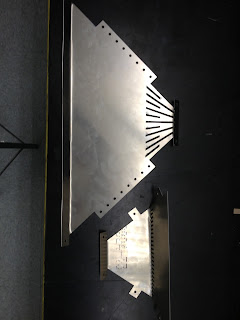On Thursday, 5/9/13, Professor Eugenia Ellis and Chloe Dye went to Computer Components Corporation (CCC), located in North Philadelphia. We met with Frank Cettina and cut the two sheets of aluminum metal into the pieces needed for the light fixture.
To do this, a large laser cutter, shown below, was used. The laser was 1/13,000 of an inch thick and used shop air as an assist gas to blow away the shards of metal left over after being cut (originally, they used Nitrogen gas, but it did not work as well).
In order to clamp down the sheet metal, the original AutoCAD file had to be rearranged. The file was then uploaded into a computer, shown below, which programmed the machine to cut.
Here is a video of the machine working!
And here is a picture of one of the components of the heatsink after being cut!

.JPG)
.JPG)
.JPG)















